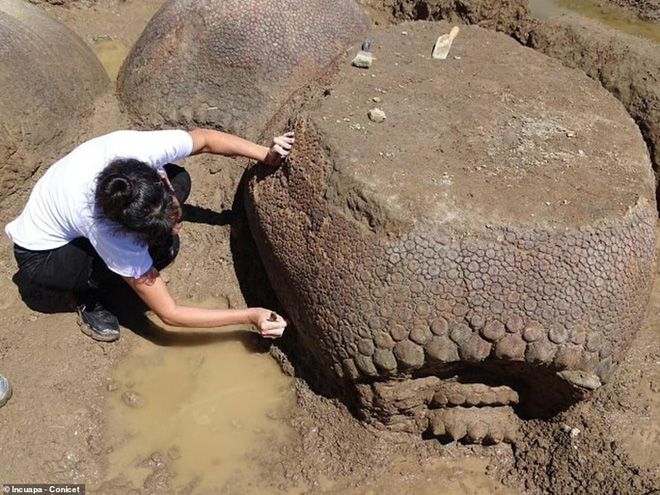Going to herd cow, accidentally discovered fossil 'monster' 20,000 years old
The discovery was made by an Argentine farmer named Juan de Dios Sota while grazing cattle on a river bank in the east of the country. According to Dios Sota, while feeding the cows, he suddenly discovered some weird and large objects in the river bed. The drought made the Vallimanca river dry up, revealing unexpected things.
Dios Sota then immediately informed the authorities. After receiving the notice, the INCUAPA Institute of Archeology of Argentina sent people to examine and discover the remains of four Glyptodo individuals.

The remains of an individual Glyptodo
It is known that this species is considered to be the ancestor of modern apricot species, which developed in South America 30 million years ago before extinction at the end of the Doi Moi 10 thousand years ago. The largest Glyptodont can weigh up to 2,000 kg.
According to biologists, Glyptodon is a herbivore and has a slow lifestyle like turtles. The survival instincts and longevity of this species are very respectable. They have super hard shells up to 5cm thick to protect themselves from other animals, including ancient, flightless birds, called Terror Bird. Even body areas not covered by the apricot layer are protected by tough bones.

The researchers found the remains of four Glyptodon individuals below the river bed
Therefore, the cause of their extinction most likely comes from humans. The shell of Glyptodon has many uses. Therefore, they were killed by humans to get apricot.
In many places in Argentina have unearthed many antiques, prehistoric living utensils made from the shells of Glyptodon. Glyptodon is the size of a car, often used to make beds, shelters, containers, or made into protective tools for people.
Meanwhile, the tail of the Glyptodon is also used to manipulate into weapons. Clusters of bones at the end of the tail are quite ideal to become prickles for human use for the purpose of hunting or fighting.

Glyptodon lived at the same time with prehistoric humans
This is the first time that up to 4 individuals of Glyptodon have been discovered in the same location. They all seem to be evacuating together somewhere. When discovered, the heads of four Glyptodons all turned in the same direction. The cause of the deaths of these individuals is still being investigated by experts.
You should read it
- Archaeologist sculpted the face of real people thousands of years ago, 'every millimeter beautiful' made many people cheated
- Prehistoric home builders living through the Ice Age from the bones of giant beasts became extinct?
- Catching a strange long-body shark like a snake, possessing up to 300 teeth and dating back to prehistoric times
- Intel launches 14th generation 'Raptor Lake-S Refresh' processor line
- Microsoft lists supported CPUs from the Meteor Lake 'Core Ultra' series and next-generation Raptor Lake
- 10 most dangerous prehistoric carnivorous dinosaurs
 The US issued an emergency permit for the COVID-19 test system 10 times faster
The US issued an emergency permit for the COVID-19 test system 10 times faster The mystery of the Pokemon episode caused nearly 700 people to be hospitalized after watching it, banned permanently screened worldwide
The mystery of the Pokemon episode caused nearly 700 people to be hospitalized after watching it, banned permanently screened worldwide The amateur astronomer discovered the unique star: it 'distorted' into a teardrop shape
The amateur astronomer discovered the unique star: it 'distorted' into a teardrop shape The largest ancient mouse that ever existed on Earth could be about the size of a bull
The largest ancient mouse that ever existed on Earth could be about the size of a bull Scientists are increasingly interested in warp engines, which 'space distortion' technology allows us to travel at the s
Scientists are increasingly interested in warp engines, which 'space distortion' technology allows us to travel at the s The power of technology has helped Korea control Covid-19 very well
The power of technology has helped Korea control Covid-19 very well